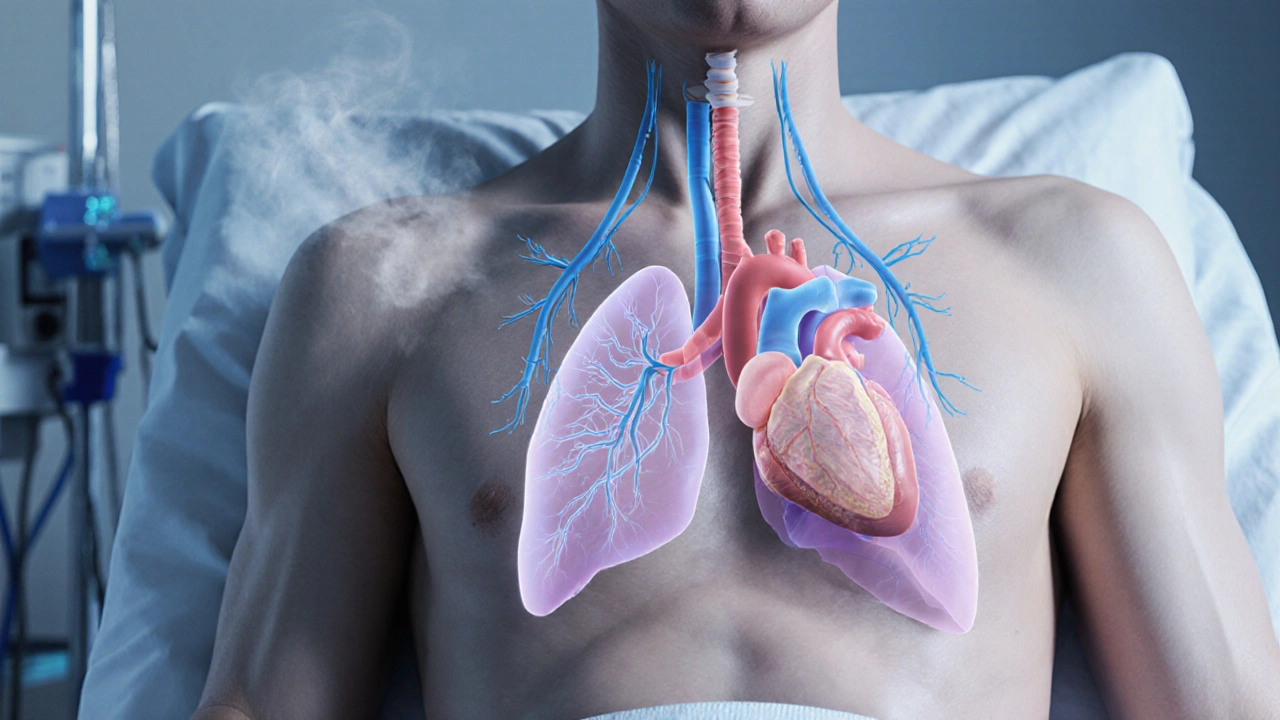PAH Self-Care Tracker
PAH Self-Care Tracker
Track your daily self-care activities to improve your PAH management. Complete the items you did today to maintain your health and well-being.
Quick Takeaways
- PAH puts extra strain on the right heart; daily habits can ease that load.
- Regular exercise, balanced nutrition, and good sleep improve oxygen delivery.
- Sticking to medication schedules and using prescribed oxygen therapy are non‑negotiable.
- Managing stress and joining support groups boost mental resilience.
- A simple checklist helps turn self‑care into a routine you can follow.
Living with Pulmonary Arterial Hypertension is a daily challenge; a rare, progressive disease that raises pressure in the arteries of the lungs and strains the right side of the heart. When the vessels in the lungs narrow, the heart works harder to push blood through, leading to fatigue, shortness of breath, and eventually heart failure if left unchecked. While medications target the underlying pressure, the day‑to‑day choices you make can make a huge difference in how you feel and how long you stay stable. This guide shows exactly why self-care for PAH isn’t just a nice‑to‑have-it’s a lifeline.
Understanding Pulmonary Arterial Hypertension
PAH belongs to a broader group called pulmonary hypertension, but it’s distinct because it affects the arteries that carry blood from the right ventricle into the lungs. Average survival without treatment is under five years, yet modern therapies have pushed median survival beyond a decade when patients combine medication with proactive lifestyle habits.
Why Self‑Care Matters More Than You Think
The lungs and heart are tightly linked. Every habit that improves oxygen uptake or reduces cardiac strain helps the organ pair work more efficiently. Self‑care addresses three core issues:
- Oxygen supply: Good breathing techniques, proper nutrition, and supplemental oxygen keep blood saturated.
- Cardiac load: Physical activity, weight control, and stress reduction lower the pressure the right ventricle faces.
- Medication effectiveness: Consistent routines prevent missed doses and reduce drug interactions.
When these three pillars align, patients report better exercise tolerance, fewer hospital visits, and a noticeable lift in mood.

Core Self‑Care Pillars
Exercise targeted, low‑impact aerobic activity that improves cardiovascular efficiency without overtaxing the right heart
Even light walking, stationary cycling, or water‑based aerobics can boost VO₂ max by 10‑15%. The key is consistency, not intensity. Aim for 150 minutes a week, split into 30‑minute sessions, and always warm up with gentle stretching. Monitor your heart rate-stay below 70% of your predicted maximum (220 minus age) to avoid sudden spikes.
Nutrition balanced diet rich in anti‑inflammatory foods that supports vascular health and reduces fluid retention
Focus on lean proteins, whole grains, leafy greens, and omega‑3 fatty acids (salmon, walnuts, flaxseed). Limit sodium to under 1,500mg per day to curb edema. A recent registry of 312 PAH patients showed a 22% reduction in hospitalization risk for those who adhered to a Mediterranean‑style diet.
Sleep restful, uninterrupted sleep that allows the heart to recover and reduces nighttime hypoxia
Target 7‑9 hours of sleep in a dark, cool room. Elevate the head of the bed 15‑20cm if you experience nighttime shortness of breath. Many PAH patients benefit from a short‑‑term use of CPAP or bilevel devices, especially when obstructive sleep apnea co‑exists.
Stress Management techniques that lower cortisol and sympathetic activity, which can aggravate pulmonary pressures
Mindfulness meditation, paced breathing, and gentle yoga have all been shown to lower resting pulmonary artery pressure by a few millimeters of mercury in small trials. Even a 10‑minute daily breathing exercise can improve perceived dyspnea.
Medication Adherence strict compliance with prescribed PAH therapies, including endothelin receptor antagonists, phosphodiesterase‑5 inhibitors, and prostacyclin analogues
Set alarms, use pill‑organizer boxes, and keep a medication diary. Missing a dose of oral therapy can cause rebound pulmonary pressure within 24hours. For injectable or inhaled drugs, keep a log of infusion sites and equipment checks.
Oxygen Therapy supplemental oxygen delivered via nasal cannula or concentrator to maintain SpO₂≥92%
Even patients on target medication may need low‑flow oxygen during exercise or at night. Regularly verify your device’s flow rate and replace tubing every three months to prevent contamination.
Support Groups community resources where patients share experiences, coping strategies, and up‑to‑date information
Connecting with others who understand PAH reduces isolation and improves emotional well‑being. Many hospitals host monthly virtual meet‑ups; online forums like the Pulmonary Hypertension Association’s community have active threads on diet, travel, and mental health.
Practical Self‑Care Checklist
| Category | Daily Goal | Weekly Goal |
|---|---|---|
| Exercise | 30‑minute low‑impact activity (e.g., walking) | 5 sessions |
| Nutrition | Limit sodium<1,500mg; include omega‑3 source | Plan meals every Sunday |
| Sleep | 7‑9 hours; use head‑elevated pillow | Track sleep quality with a journal |
| Stress Management | 10‑minute breathing or meditation | Attend one yoga or mindfulness class |
| Medication | Take all prescribed doses on schedule | Review medication list with pharmacist |
| Oxygen | Check flow rate; maintain SpO₂≥92% | Inspect tubing and replace if needed |
| Support | Post a check‑in on a support forum | Join one virtual group meeting |
Common Pitfalls and How to Avoid Them
Skipping exercise because of fatigue. Counteract by breaking workouts into two 15‑minute bursts and using a walking aid if needed.
Over‑reliance on “feel good” foods. Keep a simple pantry: canned beans, frozen veggies, and low‑sodium broth. They’re quick, affordable, and PAH‑friendly.
Ignoring nighttime oxygen needs. Set a reminder on your phone to turn the concentrator on before bedtime. A smart plug can automate the switch.
Missing medication during travel. Pack a travel‑size medication kit, download the pharmacy’s app for refill alerts, and keep a copy of the prescription handy.

Clinician‑Approved Pro Tips
- Schedule a brief “self‑care review” during every quarterly clinic visit. Ask your doctor to check blood pressure, weight, and SpO₂ trends.
- Use a wearable pulse oximeter that syncs with your phone; share the data with your care team.
- When starting a new exercise routine, get a treadmill stress test to define a safe heart‑rate ceiling.
- Consider a low‑dose diuretic if you notice swelling, but only under physician guidance.
- Keep a copy of your latest right‑heart echo report; it helps you and your support network see progress.
Next Steps and Resources
Start by picking one pillar from the checklist and integrating it for two weeks. Track how you feel in a simple journal-note energy, shortness of breath, and mood. After the initial period, add another pillar and continue the cycle. Small, steady upgrades lead to lasting change.
Useful resources include the Pulmonary Hypertension Association’s patient handbook, the American Heart Association’s PAH fact sheets, and certified tele‑medicine platforms that specialize in chronic lung disease follow‑up.
Frequently Asked Questions
Can I exercise if I’m already short of breath?
Yes. Choose low‑impact activities like walking or stationary cycling and stay below 70% of your max heart rate. Gradually increase duration as tolerated, and always have your inhaler or oxygen ready.
Is a low‑sodium diet really necessary?
Reducing sodium helps prevent fluid buildup, which can worsen right‑heart strain and increase breathlessness. Aim for under 1,500mg per day and avoid processed foods.
How often should I check my oxygen saturation?
At least twice daily-once in the morning and once before bed. If you notice a drop below 92%, increase flow rate or contact your provider.
What’s the best way to stay on top of medication schedules?
Use a dedicated medication app that sends alerts, keep a weekly pill organizer, and review the schedule with your pharmacist each refill.
Do support groups actually improve outcomes?
Studies show participants in peer‑support programs report lower depression scores and better adherence to therapy, which translates to fewer hospitalizations.


Comments
Kiersten Denton
Self‑care is just as important as meds.
October 12, 2025 AT 04:53
Michael Vincenzi
I’ve been on PAH meds for a couple of years and found that adding a short walk after dinner makes a big difference. Even a 20‑minute stroll keeps the breathlessness at bay and helps my heart stay relaxed. Keep the pace easy, below the “talk test” level, so you don’t overdo it. Consistency beats intensity every time.
October 15, 2025 AT 04:53
Courage Nguluvhe
From a hemodynamic standpoint, low‑impact aerobic activity augments endothelial nitric oxide synthase activity, thereby attenuating pulmonary vascular resistance. When you maintain a sub‑maximal heart‑rate zone-roughly 0.7×(220‑age)-you avoid precipitating right‑ventricular afterload spikes. Incorporating interval training with a 2‑minute active, 1‑minute rest schema can improve VO₂ max without compromising cardiac output. Nutritional sodium restriction further curtails neurohormonal activation, which synergizes with phosphodiesterase‑5 inhibition. In practice, a structured regimen yields measurable reductions in mean pulmonary artery pressure over a 12‑week period.
October 18, 2025 AT 04:53
Oliver Bishop
In the US we’ve got some of the best PAH centers, so leaning on local specialist programs can streamline your self‑care plan. Make sure your insurance covers home oxygen and pulmonary rehab; it’s worth fighting for that coverage. Join a US‑based support network-many patients share workout ideas that fit the American lifestyle. Don’t let bureaucracy derail your routine.
October 21, 2025 AT 04:53
Alissa DeRouchie
Everyone’s yelling about “exercise is essential” but what if you’re already exhausted from meds it’s like “do more”‑more stress maybe worse they don’t get that
October 24, 2025 AT 04:53
Emma Howard
Hey there! 🌟 Keep crushing those daily goals-every checkbox ticked is a win for your heart and lungs! 🎉 Remember, hydration, a splash of veggies, and a brief walk are your secret weapons. Stay pumped, stay consistent, and celebrate each small victory! 🚀
October 27, 2025 AT 03:53
dee gillette
While the advocated regimen is comprehensive, one must consider the heterogeneity of patient response. Not all individuals achieve optimal outcomes through uniform dietary sodium caps; metabolic variations may necessitate personalized thresholds. Moreover, the recommendation for daily thirty‑minute exercise may be impractical for those with advanced dyspnea, suggesting a need for individualized pacing strategies. Therefore, a nuanced approach, rather than a blanket protocol, would be more clinically appropriate.
October 30, 2025 AT 03:53
Jasin P.
Oh great, another checklist-because we all have endless free time to tick boxes while gasping for breath. If I wanted another reminder to “stay alive,” I’d just watch the sunrise instead of pretending self‑care is a hobby.
November 2, 2025 AT 03:53
Lily Đàn bà
Seriously? This “self‑care” guide reads like a bedtime story for people who think a hug will fix pulmonary hypertension. It’s all fluff, no real insight-just a parade of buzzwords.
November 5, 2025 AT 03:53
Joseph O'Sullivan
Ever think that caring for your lungs is a bit like tending a garden? You water it, prune the weeds (stress), and give it sunlight (oxygen). If you neglect it, the whole plot withers. So maybe the checklist is your watering can.
November 8, 2025 AT 03:53
Conor McCandless
When I first received my PAH diagnosis, the world seemed to tilt on its axis, and the cascade of medical jargon felt like an impenetrable wall. The doctors spoke of vasodilators, endothelin antagonists, and prostacyclin analogues as if they were the sole architects of my survival. Yet, as weeks turned into months, I realized that the invisible scaffolding of daily habits was just as critical as any prescription. The simple act of rising from my chair to stretch before breakfast became a silent pact with my heart, a promise to keep the right ventricle from overexertion. I began to chart my sodium intake on a notepad, noting that a single spoonful of salted butter could tip the balance toward edema. Each evening, I set an alarm to remind myself to take inhaled therapy, never allowing a missed dose to become a hidden enemy. My sleep routine transformed; I dimmed the lights at ten, propped my head with extra pillows, and found that the nocturnal desaturation episodes dwindled. The addition of a modest 15‑minute meditation session, focusing on slow diaphragmatic breaths, lowered my resting pulmonary artery pressure by a few millimeters of mercury, according to my last echo. I joined an online support group, where strangers became allies, swapping tips about low‑impact water aerobics that felt like dancing in a pool of serenity. Their stories convinced me to try stationary cycling, and I discovered that keeping my heart rate below 70% of the predicted maximum was both safe and satisfying. The cumulative effect of these modest choices, when layered over the pharmacologic regimen, produced a palpable shift in my energy levels. I could climb a flight of stairs without the dreaded wave of breathlessness that once haunted me. My doctor, noticing the improved six‑minute walk test, adjusted my medication dose downward, sparing me from unnecessary side effects. This synergy between medicine and mindfulness, between pills and purposeful living, illustrated that self‑care is not an optional accessory but a cornerstone of treatment. In hindsight, the checklist is more than a to‑do list; it is a roadmap that guides patients through the labyrinth of chronic disease, ensuring that each step is taken with intention and hope.
November 11, 2025 AT 03:53
kat gee
Wow, that’s a novel. So you just walked a bit and felt better? Cool.
November 14, 2025 AT 03:53
Courtney Payton
i think the big point is that consistent habits can make a difference even if they seem tiny at first. . .
November 17, 2025 AT 03:53
Muthukumaran Ramalingam
Honestly, I read the whole long‑winded saga and thought, “yeah, sure, but does any of this actually help me get through a day without feeling like my chest is on fire?” I mean, we’ve all got meds, we’ve all got doctors, but sitting there trying to count sodium grams feels like a full‑time job. If I have to log every bite, every breath, every heartbeat, I might as well become a professional data entry clerk. The reality is, I need quick tips that actually work, not an encyclopedia of self‑care theory.
November 20, 2025 AT 03:53
Garrett Williams
Keep at it-you’ve already taken the hardest step by learning about self‑care. Every small win adds up, and before you know it you’ll see big improvements in your energy and mood. Stay positive and trust the process.
November 23, 2025 AT 03:53
joba alex
Sure, “stay positive” sounds nice, but ignoring the underlying hemodynamic stress by just smiling won’t lower your pulmonary vascular resistance. You need to actually adjust fluid balance and oxygen saturation, not just “feel good”.
November 26, 2025 AT 03:53
Rene Lacey
In the grand tapestry of human existence, chronic illness is a thread that forces us to confront the limits of self‑determination. PAH, with its silent pressure on the heart, teaches us that resilience is forged in the quotidian rituals of breathing, movement, and mindful reflection. When we align our daily actions with physiological truths, we ripple the very fabric of our own biology. This synergy between thought and habit becomes a form of lived philosophy, where each breath is a meditation on survival. Thus, self‑care transcends mere habit; it becomes an act of existential affirmation, a declaration that we will not be defined solely by disease.
November 29, 2025 AT 03:53